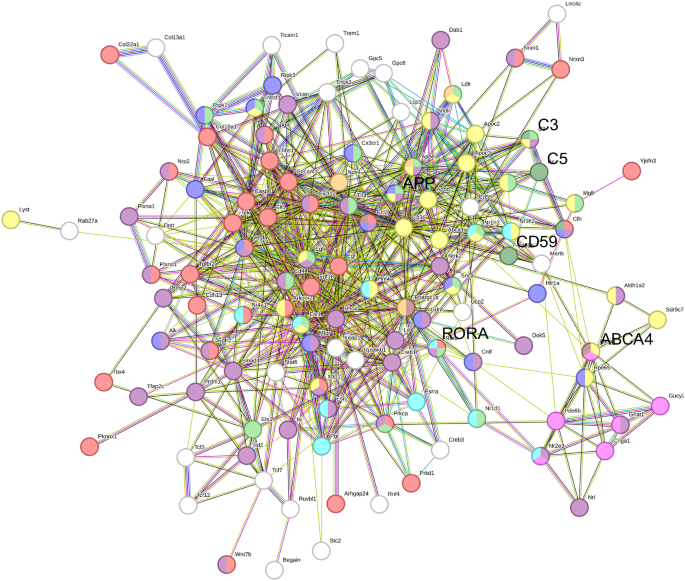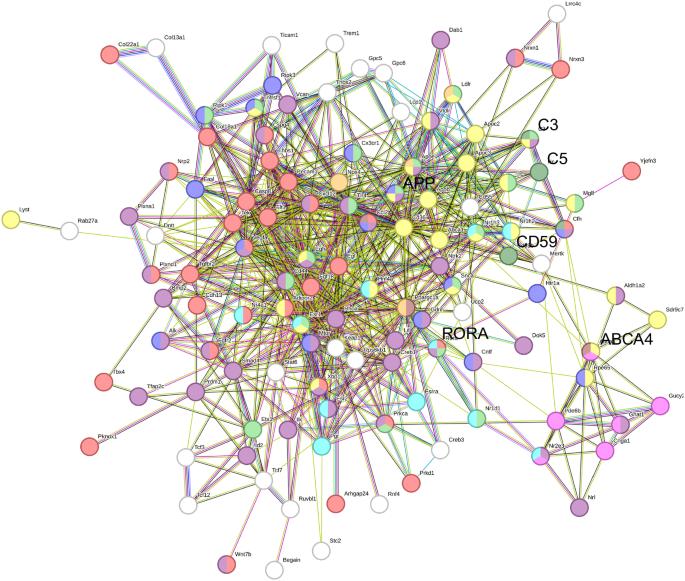视黄酸相关孤儿受体α是一种基因修饰因子,能挽救斯塔加特病和干性黄斑变性小鼠模型中的视网膜变性。
IF 4.6
3区 医学
Q1 BIOCHEMISTRY & MOLECULAR BIOLOGY
引用次数: 0
摘要
黄斑变性与几种重叠疾病有关,包括老年性黄斑变性(AMD)和斯塔加特病(STGD)。ATP结合盒式亚家族A成员4(ABCA4)的突变与晚发型干性AMD和早发型STGD有关。此外,这两种形式的黄斑变性都表现出视网膜下物质沉积和感光器变性。视黄酸相关孤儿受体α(RORA)调节包括ABCA4、CD59、C3和C5在内的AMD炎症通路。在这项转化研究中,我们考察了 RORA 在减轻视网膜变性和改善 Abca4 基因敲除(Abca4-/-)小鼠炎症反应方面的功效。与未经处理的小鼠相比,AAV5-hRORA处理的小鼠沉积物减少,CD59表达恢复,淀粉样前体蛋白(APP)表达减弱。这种分子救援与光感受器功能在统计学上的显著改善相关。这是第一项评估 RORA 修饰基因疗法对挽救视网膜变性的影响的研究。我们的研究证明了 RORA 在改善 STGD 和干性 AMD 类疾病方面的疗效。本文章由计算机程序翻译,如有差异,请以英文原文为准。


Retinoic acid related orphan receptor α is a genetic modifier that rescues retinal degeneration in a mouse model of Stargardt disease and Dry AMD
Degeneration of the macula is associated with several overlapping diseases including age-related macular degeneration (AMD) and Stargardt Disease (STGD). Mutations in ATP Binding Cassette Subfamily A Member 4 (ABCA4) are associated with late-onset dry AMD and early-onset STGD. Additionally, both forms of macular degeneration exhibit deposition of subretinal material and photoreceptor degeneration. Retinoic acid related orphan receptor α (RORA) regulates the AMD inflammation pathway that includes ABCA4, CD59, C3 and C5. In this translational study, we examined the efficacy of RORA at attenuating retinal degeneration and improving the inflammatory response in Abca4 knockout (Abca4−/−) mice. AAV5-hRORA-treated mice showed reduced deposits, restored CD59 expression and attenuated amyloid precursor protein (APP) expression compared with untreated eyes. This molecular rescue correlated with statistically significant improvement in photoreceptor function. This is the first study evaluating the impact of RORA modifier gene therapy on rescuing retinal degeneration. Our studies demonstrate efficacy of RORA in improving STGD and dry AMD-like disease.
求助全文
通过发布文献求助,成功后即可免费获取论文全文。
去求助
来源期刊

Gene Therapy
医学-生化与分子生物学
CiteScore
9.70
自引率
2.00%
发文量
67
审稿时长
4-8 weeks
期刊介绍:
Gene Therapy covers both the research and clinical applications of novel therapeutic techniques based on a genetic component. Over the last few decades, significant advances in technologies ranging from identifying novel genetic targets that cause disease through to clinical studies, which show therapeutic benefit, have elevated this multidisciplinary field to the forefront of modern medicine.
 求助内容:
求助内容: 应助结果提醒方式:
应助结果提醒方式:


